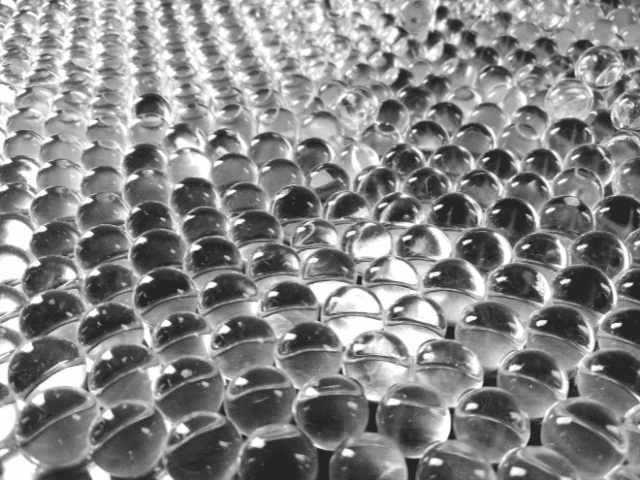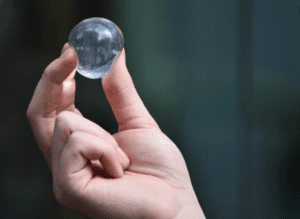Edible water is also described as “encapsulated water”
Imagine drinking water by popping the entire bottle in your mouth and consuming the bottle along with the water. The shape of an edible water bottle isn’t what you expect.
A traditional eco-friendly bottle shape is about the size of a persons hand, cylindrical with a flat base for standing and a threaded neck for the cap. An edible water bottle is a small, marble-sized spheroid that encapsulates water. In fact, a better name for the product is “encapsulated water”.
Materials that comprise an edible water bottle
An edible water bottle is a water bottle made from a material that is safe to eat. Edible water bottles are made from various materials, including seaweed, algae, gelatin, agar, and carrageenan.
These materials are derived from plants and are safe to consume. As you might imagine, edible water bottles have several advantages over traditional plastic water bottles.
Reduce reliance on plastics, fossil fuels, and production energy for making plastic bottles
By shipping water this way, a big benefit is reduction in landfill waste. Plastic water bottles are one of the biggest contributors to landfills. They take a long time to decompose, emitting carbon.
They also use a huge amount of energy to produce. If you’re interested, we estimated the carbon emissions from production of a bottle. Edible water bottles, on the other hand, don’t require a lot of energy and aren’t derived from oil-based fossil fuels.
Some people may be concerned about the safety of eating something that has been in contact with water. However, all the materials used to make edible water bottles are food-grade and have been approved by the FDA.
In addition to being environmentally friendly, edible water bottles are also very convenient. They can be stored in a purse or pocket and taken out when needed. They are also much easier to transport than traditional water bottles.

The earliest edible water bootle
The concept of the edible water bottle was first invented by the French company Skipping Rocks Lab. Their product, Ooho!, is made from brown algae and calcium chloride.
It looks like a clear, jelly-like sphere and can hold about 4 ounces (118 ml) of water. Ooho! Spheres are meant to be eaten whole, like a grape. However, if you’re not adventurous, you can also puncture the sphere and drink the water inside.
As we note above the “water bottles” are little spheroids. So you don’t hold it like a bottle. Instead you pop it in your mouth, bite down to get the liquid out, and then consume the outer skin.
Edible water bottles are a new way to package both environmentally friendly and practical water. They are easy to transport and can be stored anywhere without space in a landfill. Plus, they eliminate the need for single-use plastic bottles.
Making an edible water bottle requires a food polymer like algae
The process of making an edible water bottle is unusual. A gelatinous-like solution that is near odorless, near tasteless, is prepared.
Then a frozen ball of water is plunged into the solution. Over a short time, a membrane forms around the frozen ball. This is an “encapsulated water” sphere.
The most important part of making an edible water bottle is finding a moldable material that is safe to eat. There are several food-grade materials that you can use for this purpose, including algae, seaweed, other gelatinous sources.
Anything that is has the potential to be turned into a gel, by the addition of suitable “cross linking” agents, is a good contender.
The key will be use ingredients that are safe for consumption. Take a look at this curious video that shows a homemade process:
Why Would You Want To Use An Edible Water Bottle?
You may have seen those edible water bottles in the store and wondered what they are all about. Why would anyone want to use an edible water bottle? There are a lot of reasons! Here are just a few:
The raw material for edible water bottles are algae, seaweeds, all of which are renewable and carbon neutral in the sense that it starts with fixing it from the atmosphere into a plant and after consumption its returned into a waste carbon product. The best source would be farmed seaweed or algae.
Seaweed has been consumed for many thousands of years. It’s a good source of iodine, which is important for thyroid health. It also contains magnesium, calcium, and iron. So using an edible water bottle certainly seems innocuous and even beneficial for health.
Another reason to use an edible water bottle is that they’re pretty darn tasty. You can get them in different flavors, like grapefruit or lemon. Or you can even add your flavorings to them. They make a great and refreshing treat on a hot summer day.
So there you have it! Those are a few reasons you might want to use an edible water bottle. Why not give one a try? You might be surprised at how much you like it!

Is Edible Water Bottles The Future Of Drinking?
Imagine a world where you could simply eat your water bottle after you finished your drink. No more searching for a recycling bin and feeling guilty about the piles of plastic waste clogging up our landfills. Edible water bottles are not just the stuff of science fiction – they may soon become a reality.
Best of all, they would eliminate the need for single-use plastic bottles, dramatically reducing the plastic waste produced yearly.
While there are still some challenges to be addressed – such as finding more robust edible materials that withstand greater stresses, exposure to sunlight and heat – it is clear that edible water bottles have the potential to revolutionize the way we drink.

Anne Lauer
Anna Lauer is a writer, gardener, and homesteader living in rural Wisconsin. She has written for Mother Earth News, Grit, and Hobby Farms magazines. Anna is writing a new book about growing your food for free and an ultimate guide to producing food at little to no cost. When she’s not writing or gardening, Anna enjoys spending time with her husband and two young daughters.
